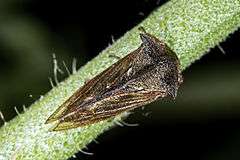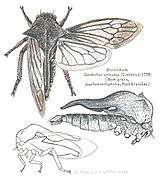Centrotus cornutus
Centrotus cornutus (thorn-hopper) is a species of "treehoppers" belonging to the family Membracidae.
| Centrotus cornutus | |
|---|---|
| Centrotus cornutus on Spanish Broom (Genista juncea) | |
| Scientific classification | |
| Kingdom: | |
| Phylum: | |
| Subphylum: | |
| Class: | |
| Order: | |
| Family: | |
| Genus: | |
| Species: | C cornutus |
| Binomial name | |
| Centrotus cornutus | |
Distribution
This species is present in most of Europe, in the eastern Palearctic ecozone and in the Near East.[1] It is one of only two UK treehoppers.[2]
Habitat
These thorn-hoppers inhabit woodlands, beech forests, hedge rows and moderately moist or dry areas.[3]
Description
The adults reach 7–10 millimetres (0.28–0.39 in) of length,[4][3] while females are slightly larger. The basic colouration of the stocky body is dark-brown. The large protruding eyes are round and reddish-brown to red. The pronotum is hairy, arched up and pulled back in a long, wave-shaped extension above the wings, with two sharp, ear-shaped lateral protrusions (hence the Latin name cornutus, meaning "horned"). The legs are very short. The front wings are pale brown and translucent, with evident brown veins.[5]
The bizarre horn-like extensions of the pronotum apparently help the camouflage. As a matter of fact, when this insect is at rest on a branch with the legs retracted, it looks like a part of the branch itself.
This species is rather similar to Gargara genistae, the second UK species of treehoppers, that lacks the horn-like protrusions, has a shorter extension above the wings and it is associated with broom.[4][6]
Biology
They can be encountered from early May through early August.[3][4] Both males and females can produce sounds and they are able to jump as orthoptera. After mating at the end of June and early July the females lay several eggs in the stalk of herbaceous plants, on which hatching larvae feed. These "treehoppers" are polyphagous, feeding on plant juices, which they take with their specially built, piercing-sucking mouth parts. The larvae mainly live on Cirsium, Carduus and Urtica species, while the adult insects prefer Populus, Quercus and Rubus species.[3] They overwinter in the litter layer in the larval stage and have a two-year life cycle.
Gallery
- Mating pair
- Side view
 Upperside
Upperside A drawing of a Centrotus cornutus
A drawing of a Centrotus cornutus
Bibliography
- Arzone A., 1971. "Illustration of the biological cycle of Centrotus cornutus L. in Piedmont" (Hem. Hom. Membracidae). Annali della Facolta di Scienze Agrarie della Universita degli Studi di Torin 6: 283-322
- Linnaeus, C., 1758: "Systema naturae per regna tria naturae, secundum classes, ordines, genera, species, cum characteribus, differentiis, synonymis, locis. Editio Decima, Reformata. Tomus I". Laurentii Salvii, Stockholm. 824 pp. page 435
- Mueller, 1984: "On the voltinism (generation sequence) of the treehopper Centrotus cornutus (L.) (Homoptera Auchenorrhyncha: Membracidae) and on the anidation of pluriannual insects." Zool. Jahrb. (anat. Ontog. Tiere) 111: 321-337
- Nast, J., 1987: "The Auchenorrhyncha (Homoptera) of Europe" - Annales Zoologici Warszawa 40: 535-661
- Nickel, H., 2003: "The Leafhoppers and Planthoppers of Germany (Hemiptera, Auchenorrhyncha): patterns and strategies in a highly diverse group of phytophagous insects" - Pensoft Series Faunistica No. 28, Sofia-Moscow, Keltern, 1-460
- Nickel, Herbert & Remane, Reinhard, 2002: "Check list of the planthoppers and leafhoppers of Germany, with notes on food plants, diet width, life cycles, geographic range and conservation status (Hemiptera, Fulgoromorpha and Cicadomorpha)". Beiträge zur Zikadenkunde No.5, pp.27-64.
- Świerczewski, D., & Stroiński, A., 2011: "The first records of the Nearctic treehopper Sictocephala bisonia in Poland (Hemiptera: Cicadomorpha: Membracidae) with some comments on this potential post". Polish Journal of Entomology/Polskie Pismo Entomologiczne 80: 13-22
References
| Wikispecies has information related to Centrotus cornutus |
| Wikimedia Commons has media related to Centrotus cornutus. |
- Fauna europaea
- Nature Spot
- Commanster
- British Bugs
- The Penny Cyclopædia of the Society for the Diffusion of Useful Knowledge - Vol. 9
- Holzinger W. E., I. Kammerlander & H. Nickel. The Auchenorrhyncha of Central Europe - Die Zikaden Mitteleuropas. Fulgoromorpha, Cicadomorpha excl. Cicadellidae - Key to the Membracidae genera and species 2003.- Т. I.- С. 529.- 674 с.- ISBN 90-04-12895-6